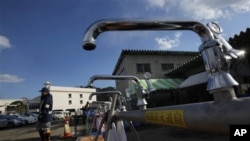Japan's prime minister says the country is on "maximum alert" over its nuclear crisis as radiation continues to seep out of the disabled Fukushima nuclear plant and traces of plutonium have been found in the soil.
Prime Minister Naoto Kan on Tuesday also warned that the situation remains "unpredictable" at the earthquake-damaged plant. He said his government is giving its complete attention to halting the radiation leaks.
Officials announced earlier that dangerous plutonium has been detected in the soil in five locations around the plant, more than two weeks after a massive earthquake and tsunami crippled the plant's cooling systems.
The International Atomic Energy Agency (IAEA) said the levels did not exceed normal background levels, but that the composition of the plutonium indicates at least some of it came from the nuclear plant.
Japan's top government spokesman Yukio Edano said Tuesday the government is doing everything it can to bring the situation under control. He said the US Nuclear Regulatory Commission and US Armed Forces were providing support and know-how.
Japanese officials have said the presence of plutonium in the soil is evidence of a meltdown in the core of the number 3 reactor, the only one of six at the plant that uses plutonium in its fuel.
The discovery is the latest setback in the effort to shut down the reactors, whose cooling systems were knocked out when a 9-magnitude earthquake and tsunami struck Japan on March 11.
More bodies are discovered daily as search crews make their way through the rubble of Japan's northeast coast, bringing the toll by Tuesday to more than 11,000 dead and 17,000 missing. Almost 200,000 more are still living in poorly equipped shelters.
Edano said Tuesday the government had set up a special task force dedicated to supporting the livelihood of those affected by the triple disaster.
On Monday, officials announced that water being used to keep the reactors' fuel rods from overheating has leaked into maintenance tunnels that run alongside three of the reactors and lead within 55 meters of the open ocean. Radiation in the water outside the number two reactor was measured at levels that can cause sickness within an hour.
Workers were already grappling with water at similar radiation levels inside the reactor building, where two workers suffered radiation burns after stepping in the water last week. Authorities say the water must be safely removed from the buildings before workers can resume the crucial work of restoring electrical power to the pumps that run the plant's cooling systems.
At a news conference Tuesday, Edano described the situation as "very grave." He said the workers have no choice but to continue pumping water into the reactors to keep the fuel rods from overheating, even as they confront the challenge of disposing with the contaminated runoff.
Radiation escaping from the plant has made its way into milk and vegetables in the surrounding province and into ocean areas near the facility. It has also infected tap water in Tokyo, 220 kilometers to the south, and has been detected at trace levels as far away as China and South Korea.
Some information for this report was provided by AP, AFP and Reuters.








